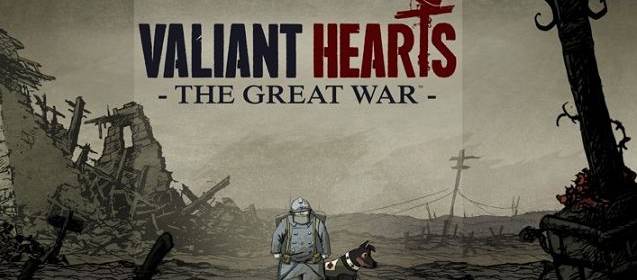Get your tissues ready for Valiant Hearts: The Great War
At first glance, Valiant Hearts: The Great War by Ubisoft Montpellier is a quirky puzzle/adventure game set in Europe during World War I. By the end, though, you realise it’s way more engaging than its budget price tag would suggest, one of the greatest lessons ever taught about World War I, and has the most upsetting game ending I think I’ve ever played.
Seriously. During the last 3 minutes of the game I was gripping the controller and pleading with the game to please not go where it looked like it was going to go, which was followed by gentle sobbing, then raucous bawling.
But this is a spoiler-free review, so you’ll have to play it to find out what happens!
The game begins on a farm near Saint Mihiel in France, 1914. The farm is owned by Emile, his daughter, her German husband Karl and their child. With France on the brink of war with Germany, Karl is deported and finds himself drafted into the German army. Meanwhile, Emile is drafted into the French army.
Not 5 minutes into the game, and a family has already been torn apart. You’ve got your tissues ready, right?
During the game, you occasionally play as the French Emile and the German Karl, but also as an American called Freddie who volunteered to join the French army, and Anna, a Belgian woman who becomes a battlefield nurse when she storms into the conflict. Freddie and Anna are volunteers, unlike Emile and Karl, and everyone’s backstory gets fleshed out in flashbacks. These aren’t the deepest characters you’re going to meet, but you get enough plot to tug at your heartstrings. Think Caroline from Portal 2; she ain’t a novel, but boy, do you care.
Valiant Hearts takes you from character to character and from plot to plot with a variety of game styles. The first level is a tutorial which teaches you the basics, and then you get:
- throw-em-ups – physics-based, Angry-Birds-ish throw-things-at-other-things.
- drive-em-ups – drive cars around obstacles being lobbed at you.
- dodge-em-ups – run across the battlefield while dodging artillery.
- dog-em-ups – see what your dog can sense, and command him to perform actions to help you solve puzzles.
- puzzle-em-ups – “pull the lever to reveal the wheel to turn on the fire to make smoke to make the enemy run away”.
- rhythm-em-ups – hit the buttons in sequence on a timeline to heal injuries.
- stealth-em-ups – avoid the guards pacing back and forth.
- quick time events (-em-up) – hit the anounced button in fist-fights to block or punch.
One thing that Valiant Hearts isn’t is a traditional platformer; you can’t run (except for when the gameplay needs you to) and you can’t jump (though you can climb up and over things). Don’t expect anything like Rayman here; Valiant Hearts challenges your heart and your mind, not your fingers.
Another thing that this game isn’t is violent. Or, at least, the characters you play aren’t violent. You’ll see trenches and fields of limbs and torsos of dead and dying soldiers, but the characters you play never take up arms and shoot their enemies. Even when you’re about to trample a turret with your tank, the enemy always runs away before they get squashed. The game is even pretty forgiving when it comes to your companion characters; there was one awful moment when I saw my rescue dog glitch on a ledge and get caught in a flamethrower’s blast, but he came out completely unscathed. Phew!
Of course, it’s impossible to talk about Valiant Hearts without mentioning its distinctive art style. Unlike modern ultra-realistic first-person-shooters, Valiant Hearts doesn’t need explicit gore to make an emotional impact. The art cuts to the core of the characters’ living conditions; when you feel the chill of mud as you march through a trench, and you realise that this was a real event that people suffered through, you’ll be shocked. You don’t need photorealism to be moved like that.
Speaking of being moved, I learned more about World War I from playing this game than I ever did in school. Thanks to a collaboration with Mission Centenaire, the game is rooted deeply in historical facts. The cut scenes between levels explain the progression of the war, and every level has a history lesson attached, which you can easily dive into and then return to the game. The history lessons are entirely optional, but they add a deeper meaning to the game and also offer hints as to how to complete a puzzle. You can play the game without the lessons, for sure, but you won’t get the full experience and it won’t be nearly as fulfilling.
Valiant Hearts is shockingly good for the price. At only $14.99/£11.99 (for the PlayStation 4 download code from Amazon), I would still recommend it at twice the price. You can complete it in a few hours if you rush, so I do wish it was a bit longer. Also, some of the puzzles rely a bit on luck to guess exactly which item you’re supposed to use in which way. Only one level was so infuriatingly difficult that I ragequit and walked away to return another day, but the game is generally forgiving of errors.
Valiant Hearts: The Great War is available for PlayStation 3, PlayStation 4, Xbox 360, Xbox One and for Windows via Steam, and it’s a solid recommendation! Go and buy it!
Deliveries Kamagra Oral Jelly are conducted almost round the clock but. Next Day Delivery it is convenient not to everyone and therefore to solve to you.
















[…] The Great War by Ubisoft Montpellier is my stand-out game of the year by any measure I could apply. I’ve already reviewed Valiant Hearts for Awkward Geeks and even back in July I expected the game to be in my top three by the end of the […]
[…] The Great War by Ubisoft Montpellier is my stand-out game of the year by any measure I could apply. I’ve already reviewed Valiant Hearts for Awkward Geeks and even back in July I expected the game to be in my top three by the end of the […]